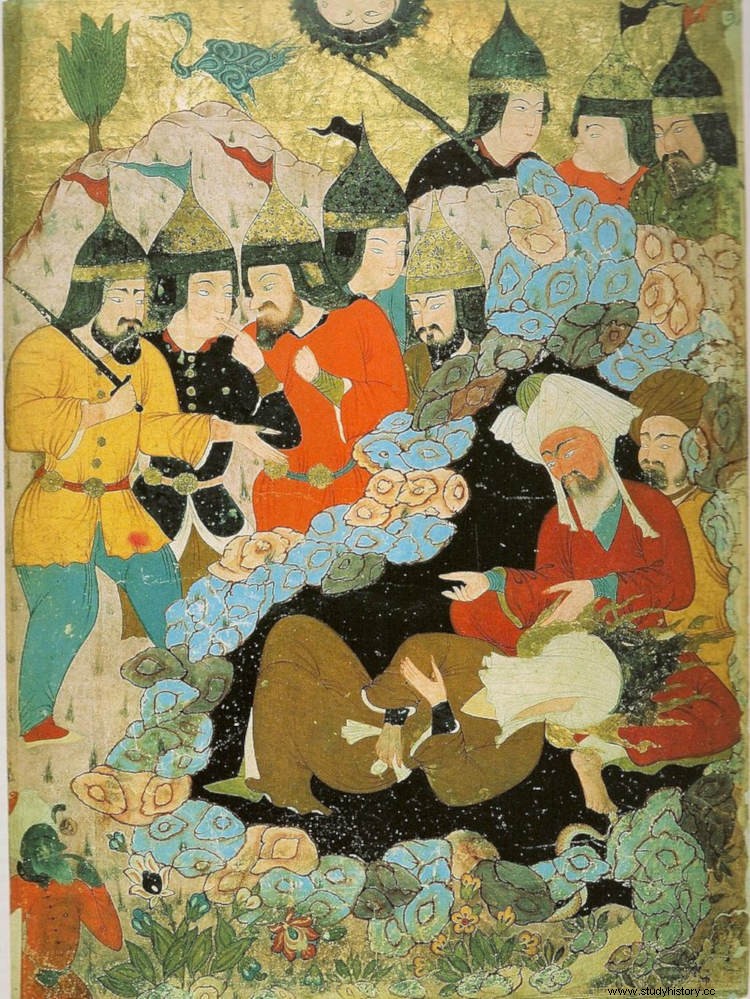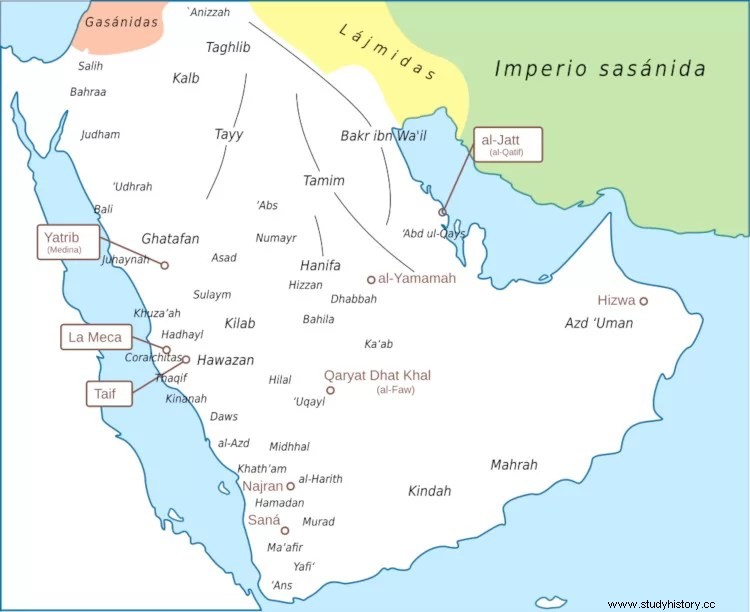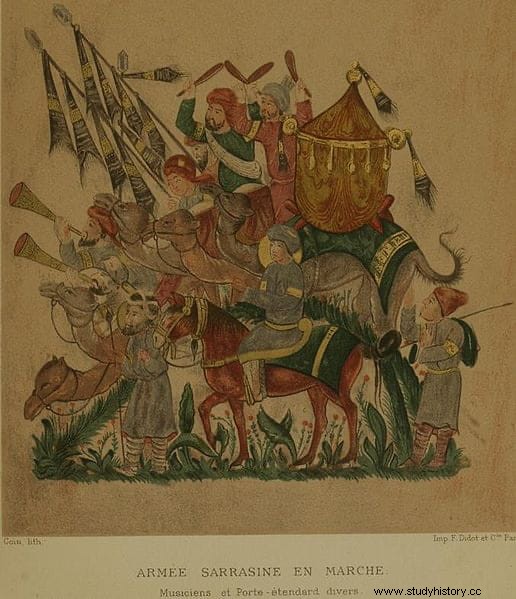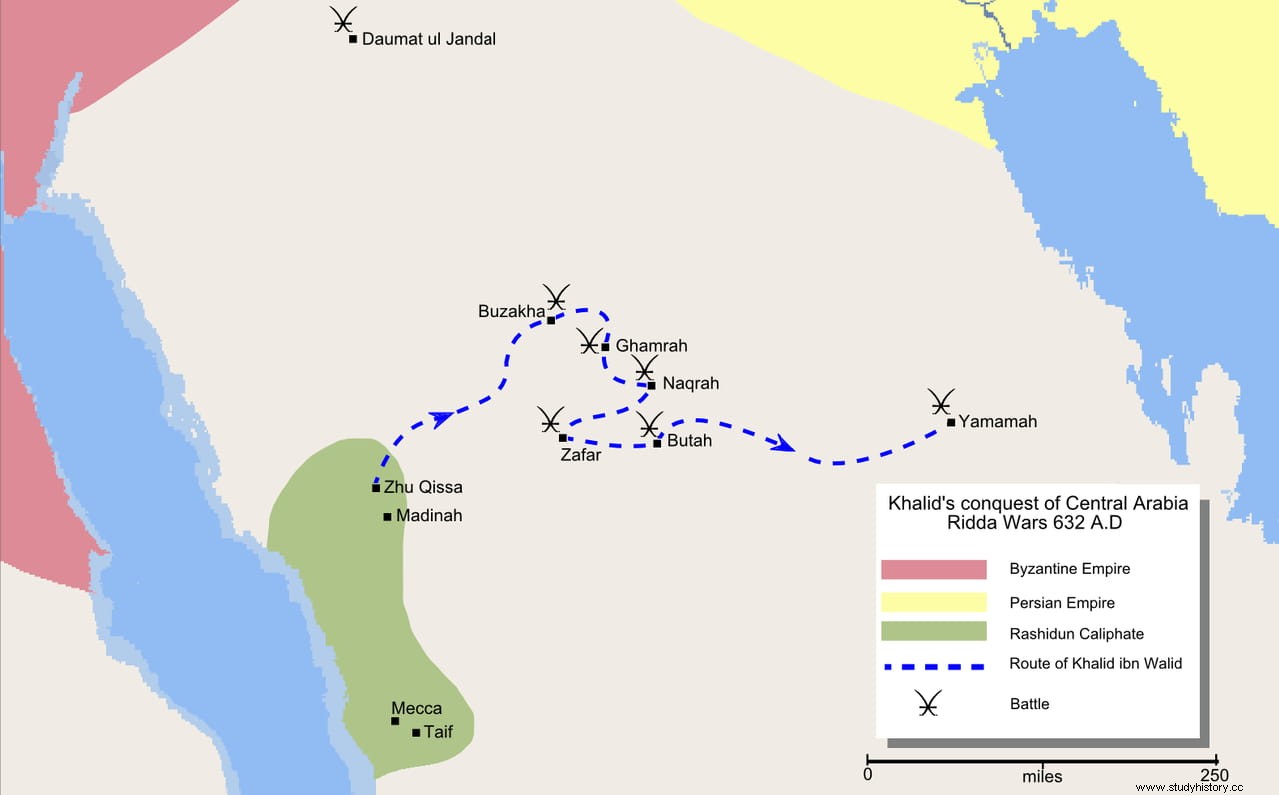Muhammad died in the summer of the year 632, perhaps poisoned, perhaps by a fatal disease. The Muslim leaders chose his mother-in-law, Abu Bakr, as his successor, but it was not easy for him to maintain the legacy, since the numerous prophets who had arisen at the risk of Muhammad's success refused to obey the new leader to carry out their own religious projects. This situation led to the so-called Ridda Wars, which would mean the repression of the apostate attempt, the unification of the Arabian peninsula and the expansion of Islam to the Syrian-Palestinian strip.
Abu Bakr as-Siddiq, father of Aisha (the third wife of Muhammad) was already the favorite of the Prophet in life. Former merchant of the Koraichita tribe (the one that controlled Mecca), he was seduced by the new faith preached by the one who would be his son-in-law and accompanied him to the hijra (exile in Medina).
When Muhammad died and was proclaimed caliph he met with opposition from Usama ibn Zaid, whom the Prophet had appointed as general of an army that aimed to attack the Byzantine Empire and therefore considered himself more entitled to succession. Ali Ibn Abi Tálib, Muhammad's cousin and son-in-law, married to his daughter, Fatima, was also not satisfied, because after all he had been the first to embrace the Islamic religion.

However, both ended up accepting the authority of Abu Bakr and their differences would not explode until many years later, when they caused the split of the Muslims into three branches:Sunnis, Shiites and Kharijites. For now, the real problem turned out to be that many of the tribes that had submitted to Muhammad did not want to recognize his successor or pay tribute to Medina. The same year of his election, rebellions broke out in the regions of Hejaz -which rejected the imposition of Islam- and Néyed -reluctant to pay the caliphate the corresponding zakah (a tax on personal wealth intended for the poor)-. The two riots were put down but it was only the beginning of something bigger.
First, Usama had to develop a war campaign to placate the tribes of Tabuk (a region in the northwest of present-day Saudi Arabia); he emerged victorious and they all agreed to continue practicing the Islamic faith and obey the orders issued from Medina except for that of el Quza'a, who persisted in his insurrection and would be definitively defeated by General Amr ibn al-As. Meanwhile, Usama continued to advance and prevailed over two tribes of Christian Arabs:the Ghassanid and the Banu Kalb. The serious thing was that Medina was left partially unprotected and three rebel tribes took advantage of this to surround it:Banu Ghatafan, Hawazin and Tayy.

Abu Bakr had to resort to all available troops, the bulk of his troops being the Banu Hashim, the clan of the Quraysh tribe to which Muhammad belonged, who were joined by the forces of Ali, Talhah and Zubair ibn al-Awam, these last two old companions of the Prophet. The three of them launched a surprise attack on their besiegers, putting them to flight. The caliph then met with Usama at Dhu Hussa to face Tulayha, a new apostate prophet. But the poor training of their camels caused them to scatter with the noise of battle and the Muslims had to withdraw to entrench themselves in Medina. From there, they counterattacked that same night and ended up winning.
Tulayha, from the Banu Asad ibn Khuzaymah tribe, was one of the three main prophets who took advantage of the wake left by Muhammad, whom he had already faced in the year 631. After his failure in Medina he tried to reorganize himself in Abraq; uselessly because his adversaries had also done so, they persecuted him there and defeated him the following year. He was able to flee to Syria... which was conquered soon after and so he had no choice but to embrace Islam, becoming one of his military commanders; he would perish defending that cause before the Persians. Now, we have spoken of prophets, in the plural, because there were more.

One was Al-Aswad Al-Ansi, who is also known as Abdhala bin K'ab. Leader of the Yemeni Al-Ansi tribe, he used to cover his face with a veil to create an aura of mystery around himself. He rebelled against the Mohammedan faith after its founder made her final pilgrimage to Mecca, taking the opportunity to raise the regions of Najran and Yemen. He would not last long, being defeated and killed by the Muslim Persian Fayruz al-Daylami, although his followers tried to resist for a time.
Other prominent prophets were Malik bin Nuwaira, in Butah, or Musaylima, in Al-Yamama. There was even a prophetess, Sajah, a Christian Arab from the Banu Tamim tribe who had a reputation as a fortune teller and gathered four thousand faithful to join the aforementioned siege of Medina, although when the news of Tulayha's defeat arrived she changed her plan and started a marriage alliance with Musaylima. Precisely this would be the main enemy of Abu Bakr, who already advanced in the summer of 632 began what is known as the Apostasy Campaign with all his troops. to finish once and for all with the insurgents; If until then his strategy had been basically defensive to protect Medina, now he went on the offensive.
Movements had sprung up in many places, from southern and eastern Arabia to the aforementioned Yemen, passing through Bahrain, Oman, Mahra and Hadramaut, as well as other points scattered throughout the Arabian peninsula. Abu Bakr divided his army into eleven corps, each of which he charged with crushing minor rebellions. The command of the strongest contingent went to Khalid ibn al-Walid, another companion of Muhammad who was nicknamed Sayf Allah al-Maslūl (the sword in the hand of God) for his splendid military virtues and who should be in charge of the most powerful revuletas to finally converge all against the greatest danger:Musaylima.
Musaylima has passed into Muslim tradition as al-Kaḏḏāb, that is, liar or false prophet. He was actually called Maslamah ibn Ḥabīb and belonged to one of the largest tribes in Arabia, that of Banu Haifa, from the central peninsular area, most of which was made up of Christian converts to Islam. His doctrine had many points of contact with that new religion, since he worshiped Allah - to whom he prayed three times a day -, prohibited pork and alcohol, rejected circumcision and observed fasting during Ramadan. . Magical powers were attributed to him and he was fond of writing poetry.
Having arisen almost at the same time as Muhammad, he offered the latter by letter to share power in Arabia but the offer was rejected. Following the example of both, other prophets arose, as we saw, who ended up rising up against the caliphate; and as we also saw, one of them was Sajah, with whom he married to make a common front against Khalid's army, who after defeating Tulayha had turned against Malik ibn Nuwayrah, a sahabi chief of the Beni Yarbu, part of the powerful northeastern tribe of Beni Tamim. Paradoxically, Malik had been one of Muhammad's trusted men -his treasurer, to be exact-, but when the Prophet died, he distributed the money collected in his name, believing that this was fulfilling his will.

Aware of Khalid's imminent arrival, he did not oppose him, hoping to clear up any misunderstandings. However, he was arrested and charged with apostasy; also of treason, for having negotiated with Sajah, which led to his death sentence. His immediate execution sparked numerous protests calling on Abu Bakr to remove Khalid; he defended himself by saying that his assistants had misinterpreted his orders and was finally exonerated after apologizing. Since Malik had no army, his followers, who had scattered across the desert on his prudent instructions, were not a problem. It was time to face Musaylima and Sajah.
Both had their core of action in Al-Yamama, a region to the east of the Néjed plateau, where Abu Bakr tried to fix them through a delaying negotiation proposal to give Khalid time to finish the pending operations. But the emissary, one of his lieutenants named Ikrima ibn Abi Jahl, had just received reinforcements and did not want to wait, so he attacked on his behalf. He was defeated and the caliph dismissed him, ordering Khalid to go there without further delay. Another impatient commander, Shurahbil, had also been defeated, so Khalid incorporated the remnants of that troop into his own and reinforced by an army sent by Abu Bakr, made up of ansar warriors. (very light and mobile auxiliaries) and muhajirun (the first converts to Islam), he added thirteen thousand men with whom he launched the attack.
Musaylima's forces were four times greater in number and the clash was brutal, to the point that the wadi that served as the battlefield was forever baptized with the name Shueib-ud-Dam (Blood Ravine). Exhausted after hours of fighting, both sides retired to rest but the duel would not end in a draw because the Muslims returned to the charge and the rebels gave in little by little, being decimated until only seven thousand were left in conditions to continue fighting and withdrawing to a walled garden. They could not resist and Khalid's soldiers entered, causing the most dramatic and bloody episode.
Legend has it that a javelin thrown by Wahshi ibn Harb (a companion of Muhammad famous for having killed his uncle in the battle of Uhud who refused to convert) killed Musaylima. Whether true or not, the fact is that the adventure of the considered false prophet ended there, along with the seven thousand bodies of his people. No wonder the place is known as the Garden of Death. Seventy huffaz also died in the Muslim ranks. (that is, scholars who had memorized the Koran), which would force Abu Bakr to collect all the texts he found to make a unified copy. For his part, Sajah survived and had no choice but to agree to convert to Islam.
The Ridda Wars, which the Shiites consider illegitimate because they were carried out by a leader they do not recognize, would still last a year, while the last pockets of resistance were crushed. The one that closed the series was that of Hadhramaut, an independent sultanate that did not rise up until January 633 under the leadership of Al-Ash'ath ibn Qays, chief of the Kindah tribe. Defeated, he was arrested by the caliph who, given his signs of repentance, ended up forgiving him. The new religion and the Rashidun Caliphate had been saved and now it was time to open another stage:the expansion, in which its first objectives were Persia and the Byzantine province of Syria.
